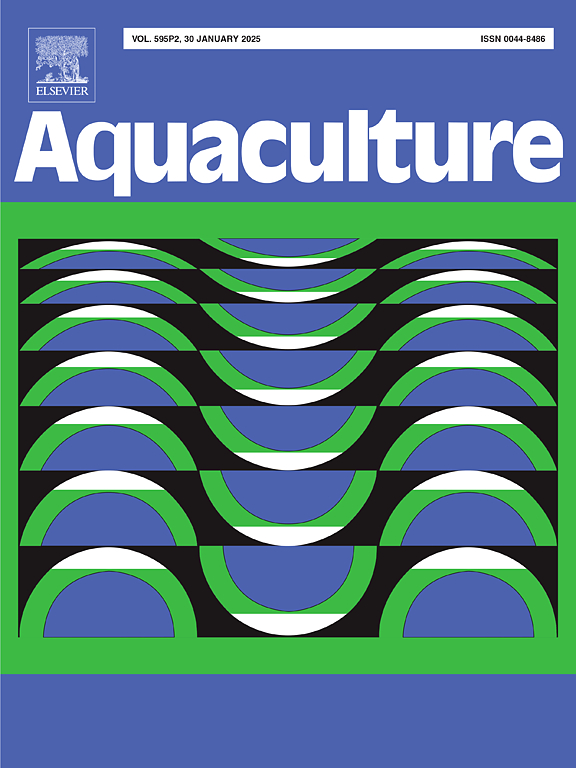Growth, appetite, and mineral deposition in rainbow trout reared in fresh- or seawater under different CO2 regimes
IF 3.9
1区 农林科学
Q1 FISHERIES
引用次数: 0
Abstract
Despite degassing efforts in recirculating aquaculture systems (RAS) and short hydraulic retention time in rearing units, carbon dioxide (CO2) concentrations reach a hypercapnic steady state. Furthermore, as CO2 excretion is correlated with the oxygen consumption of fish and bacteria, CO2 levels in RAS may undergo fluctuations, of greater or smaller magnitude, depending on systems design and operation. Experimental approaches to assess the effects of CO2 on fish usually subject fish to constant CO2 concentrations, which might not reflect rearing conditions on an industrial production scale. Here, we compare the effects of oscillating against constantly elevated CO2 levels on the appetite, growth, feed utilization, and mineral deposition in three separate growth trials. Two trials were conducted in freshwater (FW) and one in seawater (SW). In each trial, rainbow trout (Oncorhynchus mykiss) were subjected to four different CO2 treatments: either constant levels of 10 mg/L CO2 (pCO2 = 3.86 mmHg in FW / 4.57 mmHg in SW), 25 mg/L CO2 (pCO2 = 9.65 mmHg in FW / 11.42 mmHg in SW), fluctuating between these two concentrations over 24 h, or normocapnic control conditions of ≤3 mg/L CO2 (pCO2 ≤ 1.16 mmHg in FW / 1.37 mmHg in SW) for at least 5 weeks on fixed daily rations of 1.3 % of the tank biomass. In one of the freshwater trials, the diet contained high levels of phosphorus (1.8 %) to assess if elevated dietary phosphorus concentrations promoted mineralization in kidney tissues (nephrocalcinosis) under hypercapnic conditions. In both freshwater trials, fish at all CO2 levels accepted the offered feed, while in seawater daily feed intake was reduced by 35 % at exposure to 25 mg/L CO2 (pCO2 = 11.42 mmHg). Despite accepting the full, albeit restricted ration, fish reared in freshwater showed that CO2 affected appetite, evidenced by changes in mRNA expression of appetite-regulating peptides in the hypothalamus and liver of the fish. This finding was confirmed by a maximum voluntary feed intake test, showing that fish consumed less food at higher CO2 concentrations. Despite consuming similar daily ration sizes, the specific growth rate (SGR) and feed conversion ratio (FCR) were significantly affected in the 25 mg/L freshwater group (pCO2 = 9.65 mmHg) but not at 10 mg/L (pCO2 = 3.86 mmHg) or when oscillating between those concentrations. In the seawater trial, however, SGR and FCR of the trout were already significantly reduced at 10 mg/L of dissolved CO2 (pCO2 = 4.57 mmHg) compared to the control group, but even more so in the 25 mg/L CO2 group (pCO2 = 11.42 mmHg). While the CO2 regimes applied in this study and high dietary phosphorous did not result in clear macroscopic pathologies indicative of nephrocalcinosis, there was calcium deposition in trout kidneys was highly elevated in the 25 mg/L group (pCO2 = 9.65 mmHg), indicating the potential onset of this pathology, which was supported by histopathological examinations. Overall, the results of this study show that while fish were affected by CO2 in all trials, the severity depends on water chemistry.
求助全文
约1分钟内获得全文
求助全文
来源期刊

Aquaculture
农林科学-海洋与淡水生物学
CiteScore
8.60
自引率
17.80%
发文量
1246
审稿时长
56 days
期刊介绍:
Aquaculture is an international journal for the exploration, improvement and management of all freshwater and marine food resources. It publishes novel and innovative research of world-wide interest on farming of aquatic organisms, which includes finfish, mollusks, crustaceans and aquatic plants for human consumption. Research on ornamentals is not a focus of the Journal. Aquaculture only publishes papers with a clear relevance to improving aquaculture practices or a potential application.
 求助内容:
求助内容: 应助结果提醒方式:
应助结果提醒方式:


